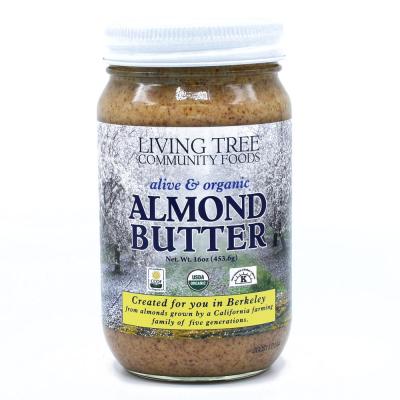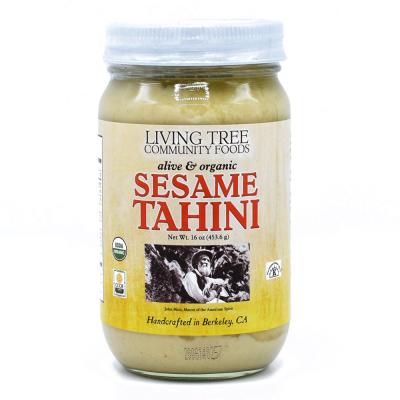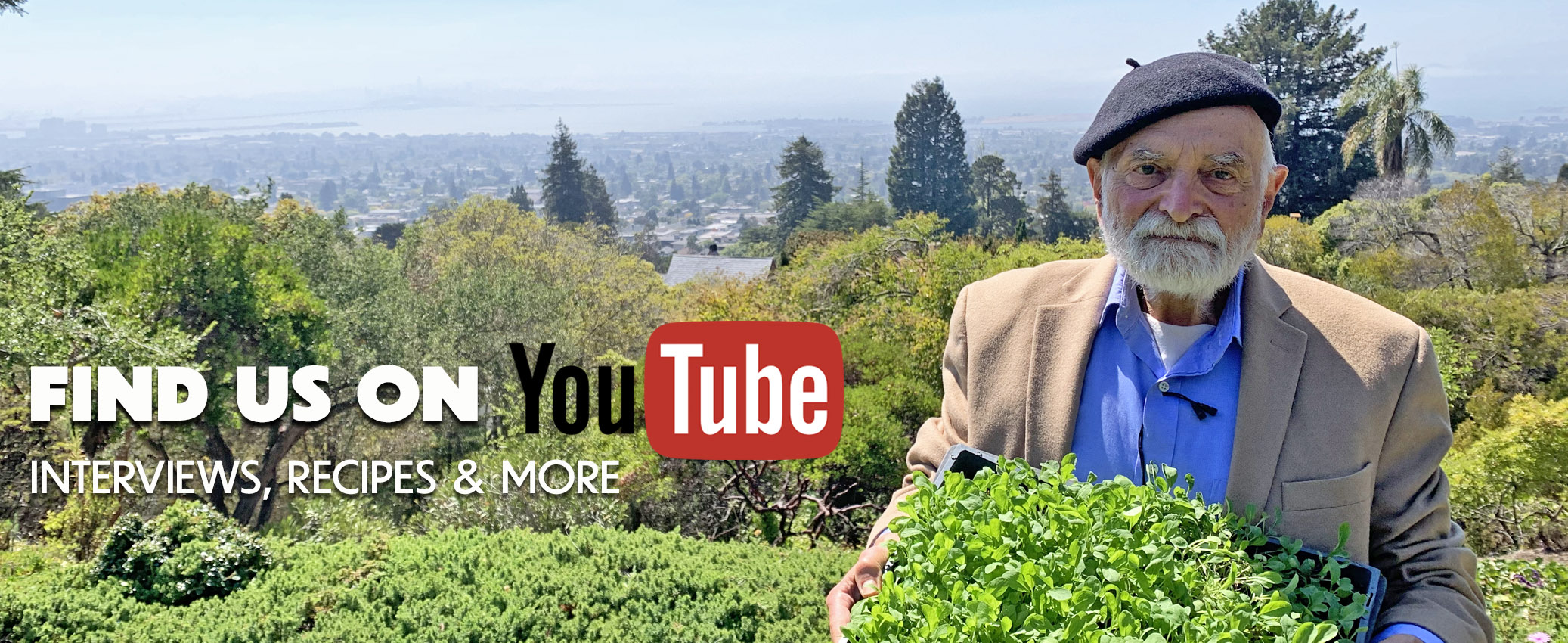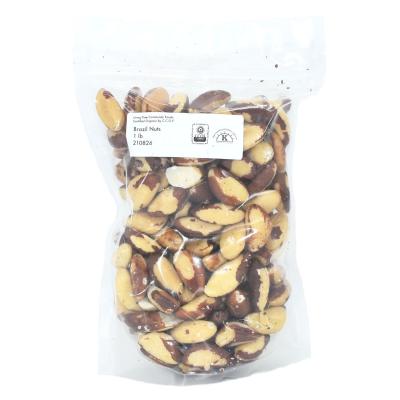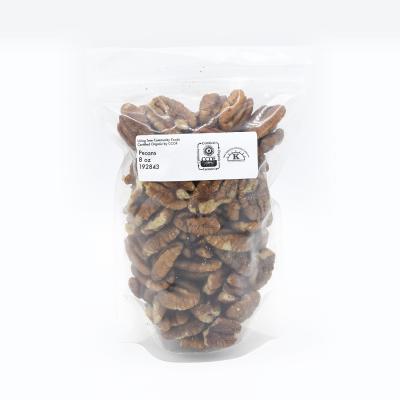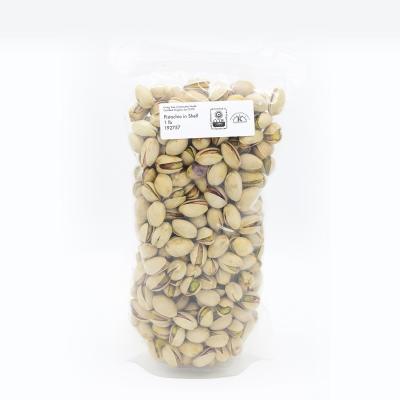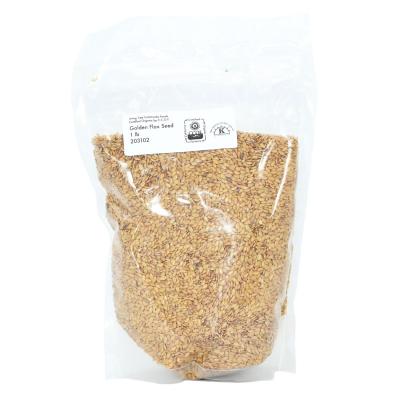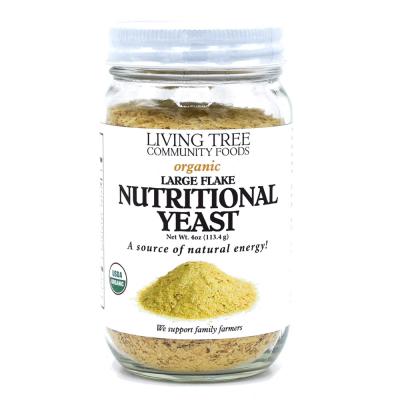
Video: Dance Ecstatic with Sweet Corn Salad!
Back in Stock!
Living Tree Community Foods Organic Almond Butter is created in Berkeley, California from alive, raw nonpareil almonds. They are grown by a California farming family of five generations. We make it slowly, in small batches, to give it a wondrous, creamy texture. Savor its aroma and taste its whole-bodied flavor. We truly make the highest quality raw almond butter on earth!
Living Tree Community Foods Organic Sesame Tahini is created in Berkeley, California from alive, raw organic sesame seeds grown by Mexican family farmers. It is produced slowly, in small batches, to give it a wondrous, creamy texture. Imagine it in hummus, alive pies, or combined with organic honey for a deliciously decadent halva.
Get Involved!
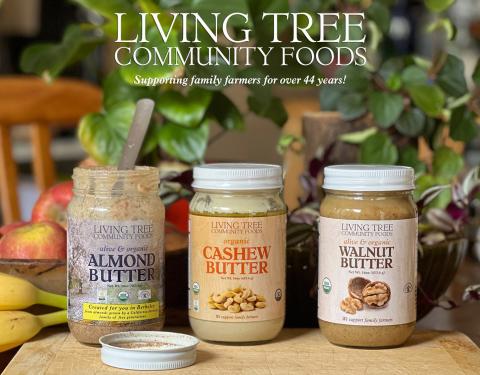
If you have a love for live, organic food and at the same time possess an entrepreneurial spirit and want to get involved in the organic food industry, why not talk with us? We are seeking a business partner.
If you’re a recent graduate and are contemplating a career in the organic food industry, why not consider doing an internship? We offer hands-on experience in sales, marketing and production of live organic food.
In the past decade, US organic retail sales increased by an average of 8% per year.
In 2023, the US organic marketplace posted record sales.
For further details email jesse@livingtreecommunity.com
Jesse Schwartz PhD
President
Living Tree Community Foods
Video: The 7 Layers of a Food Forest by Permaculture Fair Oaks
Let's Talk
Your queries, comments and suggestions are invaluable. We want to talk with you. We invite you to give us a call at 800 260 5534 12pm - 2pm (pst) Mon, Tues, Thurs & Fri.
Collapsing bird numbers in North America prompt fears of ecological crisis – research

by Patrick Greenfield
Bird populations across North America are falling most quickly in areas where they are most abundant, according to new research, prompting fears of ecological collapse in previously protected areas.
Analysis of nearly 500 bird species across North America has found that three-quarters are declining across their ranges, with two-thirds of the total shrinking significantly.
The study, published in the journal Science, indicates that former strongholds for bird species are no longer safe, particularly in grasslands, drylands and the Arctic.
In one of the most ambitious uses of citizen science data so far, scientists at the Cornell Lab of Ornithology used observations from eBird, a popular application used by birdwatchers to record sightings, to model changes between 2007 and 2021. The granularity of the data allowed researchers to track the rate of change in 27 sq km (10 sq miles) segments across North America, showing dramatic declines in areas where less than two decades ago bird species had thrived.
Video: How to Make Raw Vegan Veggie Burgers! With Shari Leiterman by FoodnSport
GMO Agriculture Linked to Soaring Use of Toxic Pesticides

By Claire Robinson
Genetically modified (GM) crops have increased agriculture’s dependence on pesticides rather than reducing it, a study published in April found.
Drawing on data from four GM crops — Bt cotton, herbicide-tolerant (HT) soybean, HT and/or Bt maize, and HT canola, the researchers — including agricultural development expert professor Glenn Davis Stone from Washington and Lee University and Bt cotton expert K. R. Kranthi of the International Cotton Advisory Committee — traced the surge in chemical use over three decades.
They found a paradox: while GM seeds were supposed to reduce pesticide use, their introduction caused pesticide use to soar. The researchers explain this outcome using the Jevons paradox, an economic theory that dates back to 1865.
British economist William Stanley Jevons argued that efficiency in resource use often leads to more, not less, consumption. The study applies this idea to GM crops, which were claimed to reduce pesticide use, but in reality have made it skyrocket.
Previous Newsletters
June 10, 2025 - Video: Imagine! Mango, Peach & Chocolate Ice Cream - Alive and Organic!
June 4, 2025 - Video: An Almond, Walnut & Pistachio Smoothie
May 27, 2025 - Video: Celebrate the Effervescence with an Almond, Walnut, & Cashew Carrot Cake - No-Bake, Alive and Organic
May 20, 2025 - Video: Abound with Marvel of Four Seasons Lettuce, Amish Paste Tomato, Siberian Kale and So Much More
May 13, 2025 - Video: Rejoice with Blueberry Cheesecake - Organic and No-Bake, Of Course!
May 6, 2025 - Video: A Spring Salad - Energetic and Vivacious
April 29, 2025 - Video: Alive, Organic Pizza: No Bake and Vital!
April 22, 2025 - Video: Rejoice with a Sweet Potato, Beet, Apple & Sunchoke Salad - Alive and Organic, Of Course!
April 8, 2025 - Video: Celebrate with a Blueberry Cheesecake - Alive, Organic and No Bake!
April 1, 2025 - Video: Rejuvenate with a Purple Carrot Cake - Alive, Organic and No Bake!
March 25, 2025 - Video: Spring Awakening in a Community Garden
March 18, 2025 - Video: Chocolate Swirl, Almond, Cashew & Tahini Halva
March 11, 2025 - Video: We Welcome Spring with a Helianthus Tuberosus Salad
March 4, 2025 - Video: America! The Almonds are Blossoming! An Interview with Steve Kortoff, Master Grower
February 25, 2025 - Video: We Celebrate Almond Blossom Time with a Pumpkin Pie! No Bake, Organic - Of Course!
February 18, 2025 - Video: Out of the Depths of Winter - A Vivacious Quinoa, Chickpea Salad!
February 11, 2025 - Video: Out of the Depths of Winter, Let's Plant for Early Spring
February 4, 2025 - Video: Kiwi Green Smoothie - Alive and Organic!
January 28, 2025 - Video: Imagine a Tray of Wheat Grass in Your Kitchen!
January 21, 2025 - Video: A Dinosaur Kale Salad - Our Answer to Winter Blues
January 14, 2025 - Video: Pumpkin Chocolate Latte Smoothie
January 7, 2025 - Video: Pumpkin Pie Cheesecake - No Bake and Organic
December 29, 2024 - Video: No Bake Carrot Cake Amidst Winter’s Doldrums
December 22, 2024 - Video: Imagine! A Persimmon, Cashew Ice Cream Cake - Organic, Of Course!
December 17, 2024 - Video: How We Came to Make Almond Butter
December 10, 2024 - Video: A Festive Salad for Winter
December 3, 2024 - Video: A Green Drink for Winter - An Outburst of Vitality
November 26, 2024 - Video: Hey Mr. Ultra Processed Man: Some Thanksgiving Thoughts
November 19, 2024 - Video: Purple Sweet Potato, Butternut Squash, Persimmon & Apple Pie - No Bake! Alive and Organic!
November 12, 2024 - Video: Celebrate Aliveness with a Waldorf Salad
November 5, 2024 - Video: Exemplify Vivacity with a No Bake Pumpkin Pie
October 29, 2024 - Video: Mango Avocado Cheesecake - No Bake & Organic
October 22, 2024 - Video: No Bake Carrot Cake - Alive & Organic
October 15, 2024 - Video: Mango Purple Sweet Potato Apple Pie - Alive, Organic & No-Bake
October 8, 2024 - Video: We Wax Ecstatic with Mango, Fig, Almond Butter Ice Cream!
October 1, 2024 - Video: Supercharge Your Green Drink with Streaming Life Energy
September 24, 2024 - Video: Planting Seeds of Redemption
September 17, 2024 - Video: Strawberry, Peach, Honeycomb Ice Cream - Alive and Organic
September 10, 2024 - Video: No-Bake Cheesecake - Strawberry, Mango & Almond Butter
September 3, 2024 - Video: Sweet Corn Tabouli - Alive & Organic
August 27, 2024 - Video: Planting Vivacity, Seeding Aliveness
August 20, 2024 - Video: Rejoice with a Green Drink Mirroring the Munificence of Midsummer
August 13, 2024 - Video: Celebrate the Season with A Midsummer Salad
August 6, 2024 - Video: A Walk Through an Edible Schoolyard
July 30, 2024 - Video: Alive & Organic No-Bake Apple Pie
July 23, 2024 - Video: Planting the Wheatgrass of Redemption
July 16, 2024 - Video: Celebrate Summer with Mango, Fig, Apricot, Peach & Almond Ice Cream
July 9, 2024 - Video: Seeds of Renewal in an Edible Schoolyard in Berkeley
July 2, 2024 - Video: Strawberry, Mango Mousse - Alive and Organic
June 25, 2024 - Video: Planting Sweetcorn in June - Its Not Too Late!
June 18, 2024 - Video: Rejoice with your Purple Sweet Potato, Cucumber, Broccoli Juice!
June 11, 2024 - Video: Juicing a Watermelon, Exemplifying Aliveness
June 4, 2024 - Video: Apricot, Peach, Mango Mousse - We Celebrate the First Fruits!
May 28, 2024 - Video: We Welcome Springtime with an Avocado, Peach, Mango Ice Cream Cake
May 21, 2024 - Video: Tomato, Kale, Cucumber Salad with Almond, Walnut, Black Tahini Dressing
May 14, 2024 - Video: Welcome Springtime with a Blueberry, Mango Cheesecake, Alive and Organic!
May 7, 2024 - Video: A Portrait of Spring at Living Tree Community Foods
May 1, 2024 - Video: Rejoice with Blueberry, Peach & Avocado Ice Cream
April 16, 2024 - Video: Emulate the Greatest Generation: Plant a Victory Garden Now!
April 9, 2024 - Video: Living Tree Alive, Organic Almond Butter: A Family Farming Treasure
April 2, 2024 - Video: Walnut, Almond & Beet Hummus
March 26, 2024 - Video: Our Almond Butter - A Treasure of California Family Farmers
March 19, 2024 - Video: Plant your Victory Garden! Emulate the Greatest Generation!
March 12, 2024 - Video: A Green Drink to Celebrate the Exuberance of Spring
March 5, 2024 - Video: Chocolate, Avocado, Pistachio, Almond Ice Cream Cake
February 27, 2024 - Video: An Intimation of Spring with Dandelion, Kale, Swiss Chard and Collard Greens
February 20, 2024 - Video: Avocado, Almond, Banana Apple Cake with Cashew Icing
February 13, 2024 - Video: Mango Avocado Cheesecake - No Bake & Organic
February 6, 2024 - Video: Breakfast with a Banana Almond Butter Smoothie
January 30, 2024 - Video: No Bake Carrot Cake Amidst Winter’s Doldrums
January 23, 2024 - Video: The Loneliness of the Purple Juice Drinker
January 16, 2024 - Video: Out of Winter Depths: A Green Drink, Vibrantly Alive
January 9, 2024 - Video: From Reform to Redemption - Some Thoughts on the Real Organic Project
January 2, 2024 - Video: Ultra Processed Man
December 26, 2023 - Video: Festive Sunchoke Salad - Alive and Organic!
December 19, 2023 - Video: Come Alive with Green Pea Hummus
December 12, 2023 - Video: Avocado, Beet Hummus
December 5, 2023 - Video: The Loneliness of the Purple Juice Drinker
November 28, 2023 - Video: A Green Drink for Winter
November 21, 2023 - Video: Rejoice with Baba Ganoush
November 14, 2023 - Video: Rejoice with a Thanksgiving Salad - Alive and Organic!
November 7, 2023 - Video: We Talk with Dave Chapman on Challenges to Organic
October 31, 2023 - Video: No-Bake Carrot Cake - Alive & Organic
October 24, 2023 - Video: A Creamy Tahini Dressing for an Exuberant Dinosaur Kale Salad
October 17, 2023 - Video: Rejoice with Pomegranate, Apple & Cucumber Juice Smoothie!
October 10, 2023 - Video: Zucchini Baba Ganoush - Alive and Organic
October 3, 2023 - Video: Sweet Potato, Apple and Cucumber Juice Smoothie
September 26, 2023 - Video: Rejoice with Baba Ganoush
September 19, 2023 - Video: Come Alive with Kale, Celery & Cucumber Juice
September 12, 2023 - Video: Juicing a Watermelon, Exemplifying Aliveness
September 5, 2023 - Video: Corn Chowder - Alive and Organic, Of Course!
August 29, 2023 - Video: Rejoice with a Fig, Peach & Avocado Smoothie!
August 22, 2023 - Video: Mediterranean Salad with Sun-dried Olives and Greek Heritage Olive Oil
August 15, 2023 - Video: Mango, Peach Almond Butter Ice Cream - Alive and Organic!
August 8, 2023 - Video: You Must Sow These Seeds in August by Ben with GrowVeg
August 1, 2023 - Video: We talk with Dave Chapman on Challenges to Organic
July 25, 2023 - Video: It's Not Too Late! Plant Your Victory Garden Now!
July 18, 2023 - Video: Mango Avocado Cheesecake - No Bake & Organic
July 11, 2023 - Video: Mango, Peach and Chia Seed Pudding
July 4, 2023 - Video: Pineapple Almond Butter Smoothie - Alive and Organic
June 27, 2023 - Video: Rejoice with Blueberry, Peach, Avocado Ice Cream
June 20, 2023 - Video: Come Alive with Green Pea Hummus
June 13, 2023 - Video: Awaken to a Banana, Almond Butter & Blueberry Smoothie
June 6, 2023 - Video: Chia Strawberry Mango Pudding for Breakfast? Why not?
May 30, 2023 - Video: We Talk with Dave Chapman on Challenges to Organic
May 23, 2023 - Video: Your Tax dollars Subsidize Junk Food
May 16, 2023 - Video: We Welcome Spring With a Mango Avocado Cheesecake, No Bake and Organic
May 9, 2023 - Video: A Garden for the American Spirit
May 2, 2023 - Video: Vanilla, Mango and Chocolate Ice Cream - Alive and Organic
April 25, 2023 - Video: Plant a Victory Garden! Alive and Organic!
April 18, 2023 - Video: Join Us for Coconut Chia Seed Pudding - Alive & Organic
April 4, 2023 - Video: The Woolly Mammoth Meatball
March 28, 2023 - Video: Mango, Avocado Cheesecake - No Bake & Organic
March 21, 2023 - Video: Apropos 1929 - Plant a Victory Garden Now!
March 14, 2023 - Video: Avocado Apple Pie - No Bake, Alive & Organic
March 7, 2023 - Video: Join Us for Coconut Chia Seed Pudding - Alive & Organic
February 28, 2023 - Video: Ebullient Kale Salad with Almond, Cashew, Black Tahini Dressing
February 21, 2023 - Video: Out of the Depths - A Victory Garden!
February 14, 2023 - Video: Fasting for Regeneration
February 7, 2023 - Video: Let’s Learn From Obesity
January 31, 2023 - Video: Watch As We Create Almond Butter, Chia Seed Pudding
January 24, 2023 - Video: The Apples and Oranges of Inflation Depression
January 17, 2023 - Video: Amidst the Winter's Drear, the Almond Trees are Rejoicing!
January 10, 2023 - Video: Almond Butter Energy Balls - Alive & Organic
January 3, 2023 - Video: The Bubble Economy and the Greatest Generation
December 27, 2022 - Video: Out of the Depths, Let’s Get Growin’ America!
December 20, 2022 - Video: Sweet Potato, Almond & Avocado Pie
December 13, 2022 - Video: Crypto and the Tulip Mania
December 6, 2022 - Video: Let’s Exemplify Aliveness with a Cheesecake from Cashew Butter - Organic Of Course!
November 29, 2022 - Video: Bye, Bye Crypto Pie, Vegan and Gluten Free, Topped with Ponzi Scheme Ice Cream
November 22, 2022 - Video: Meet the Men Who Grow Your Almonds
November 15, 2022 - Video: Avocado, Almond Butter, Chocolate Pie - Alive & Organic, Of Course!
November 8, 2022 - Video: Fasting - The Oldest Cure
November 1, 2022 - Video: The Loneliness and the Ebullience
October 25, 2022 - Video: Charles Darwin and “The Science”
October 19, 2022 - Video: America, Turn Your Banana Peels Into Gold!
October 12, 2022 - Video: 20 Million Victory Gardens
September 28, 2022 - Video: Apple, Cucumber, Tomato and Grape Juice - Supercharged!
September 20, 2022 - Video: Life Energy Will Stream with a Green Drink
September 13, 2022 - Video: Gravenstein Apple, Seckel Pear, Cucumber and Kale Juice Followed by Thoughts on Health Care
September 6, 2022 - Video: On Labor Day We Honor "The Greatest Generation"
August 30, 2022 - Video: Let’s Drink to Organic with an Almond Butter, Banana Smoothie
August 23, 2022 - Video: A Green Drink for the American Spirit
August 16, 2022 - Video: Mango, Peach and Almond Butter Ice Cream Topped with Thoughts on Ultra Processed
August 9, 2022 - Video: Food Is Medicine - Simple Steps To Fill Your Plate With Delicious Food by Julieanna Hever
August 2, 2022 - It is Not Too Late to Start a Container Garden
July 26, 2022 - Video: Drink Wheatgrass - Now!
July 19, 2022 - Video: Plant a Victory Garden “Singing So Proud to be Alive“
July 12, 2022 - Video: High Summer Avocado, Walnut & Tomato Drink
July 5, 2022 - Video: Cabbage Soup Juice - Alive and Organic, Of Course!
June 28, 2022 - Video: A Drink for These Times
June 21, 2022 - Video: We Prepare Gazpacho (A Traditional Soup) - Alive and Organic, Of Course!
June 14, 2022 - Video: A No-Bake Chocolate Cake Topped with the Highest Inflation in Four Decades
June 7, 2022 - Video: Almond, Apricot, & Peach Smoothie with Wheatgrass
May 31, 2022 - Video: Reverberate with an Avocado Chocolate Smoothie
May 24, 2022 - Video: Mango, Peach and Chia Seed Pudding
May 17, 2022 - Video: A Green Drink for the American Spirit
May 10, 2022 - Video: Five Days of Redemption
May 3, 2022 - Video: Join us for Coconut Chia Seed Pudding - Alive and Organic
April 26, 2022 - Video: Seeds of Renewal and Regeneration - A Victory Garden for the American Spirit
April 19, 2022 - Video: Do- it- yourself Almond Milk with Blueberries, Strawberries, Peaches and Cherries
April 12, 2022 - Video: The Loneliness of the Live Food Eater
April 5, 2022 - Video: The Necessity of Victory Gardens
March 29, 2022 - Video: Still NO fossils?
March 22, 2022 - Video: Wheatgrass in Your Kitchen Parsley, Lettuce and Kale in Your Backyard
March 15, 2022 - Video: Apropos Inflation and the Greatest Generation
March 8, 2022 - Video: Spring Awakening
March 1, 2022 - Video: America! The Almonds are Blossoming
February 22, 2022 - Video: Hug the Earth and Plan Your Victory Garden
February 15, 2022 - Video: Genetically Modified Environments: A Discussion
February 8, 2022 - Video: Out of the Depths, We Plant Tomatoes!
February 1, 2022 - Video: A Green Drink for the American Spirit
January 25, 2022 - Video: From the Winter of Our Discontent, A Garden for Early Spring
January 18, 2022 - Video: The Arrival of the Fittest - Some reflections on Alfred Russell Wallace
January 11, 2022 - Video: Some Reflections on the Greatest Generation
January 4, 2022 - Video: Let's Get Back to Our Vital Roots


